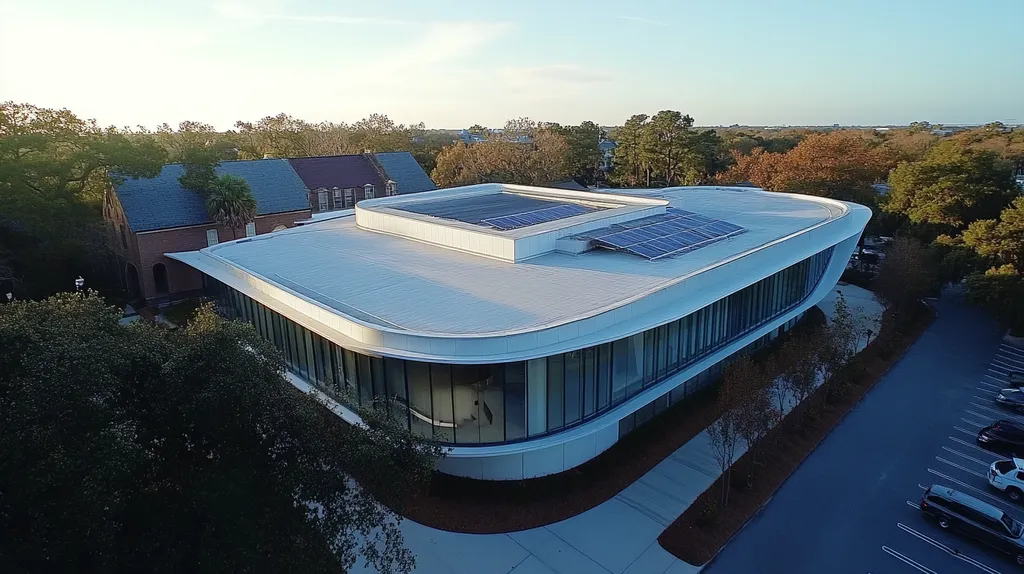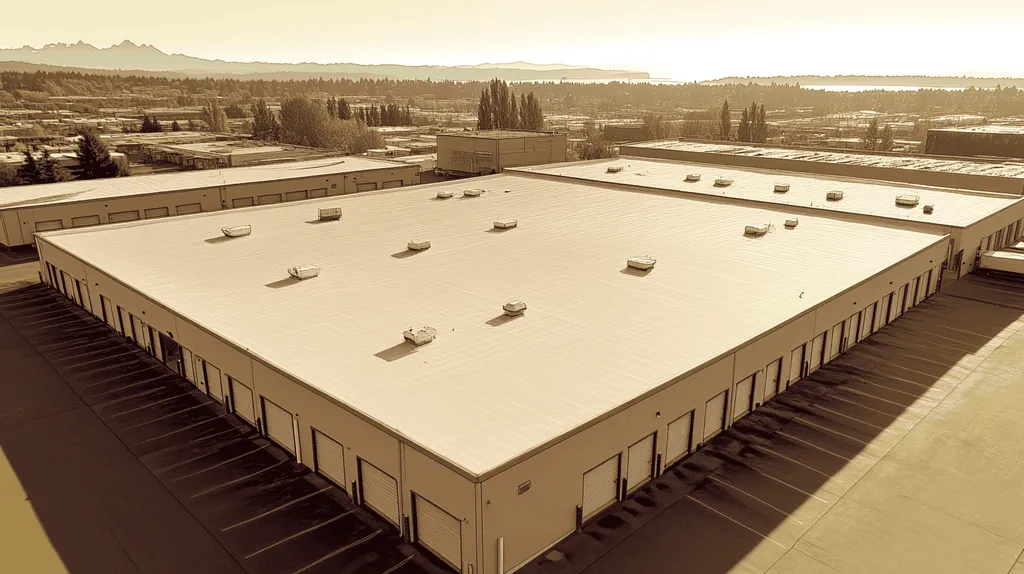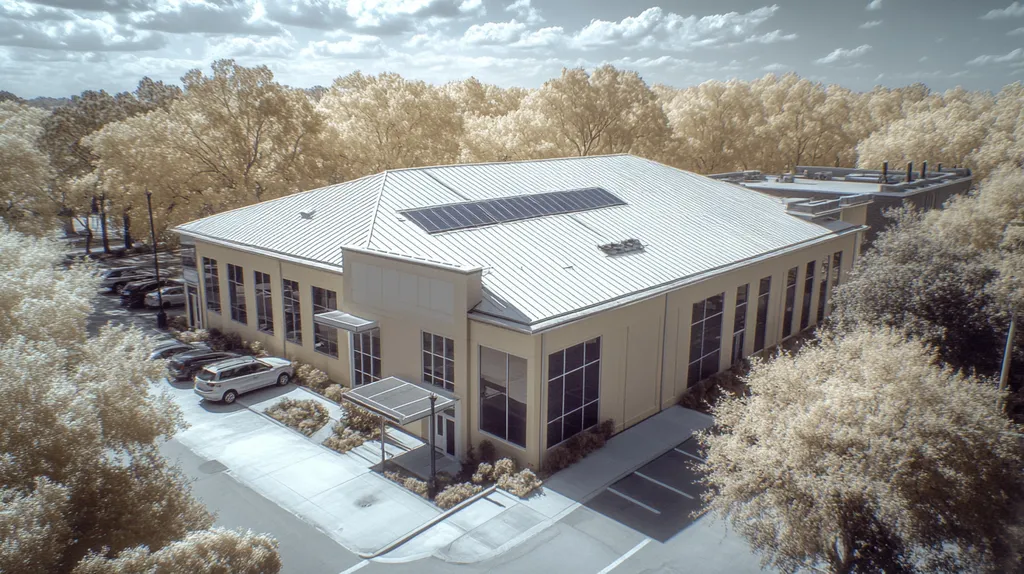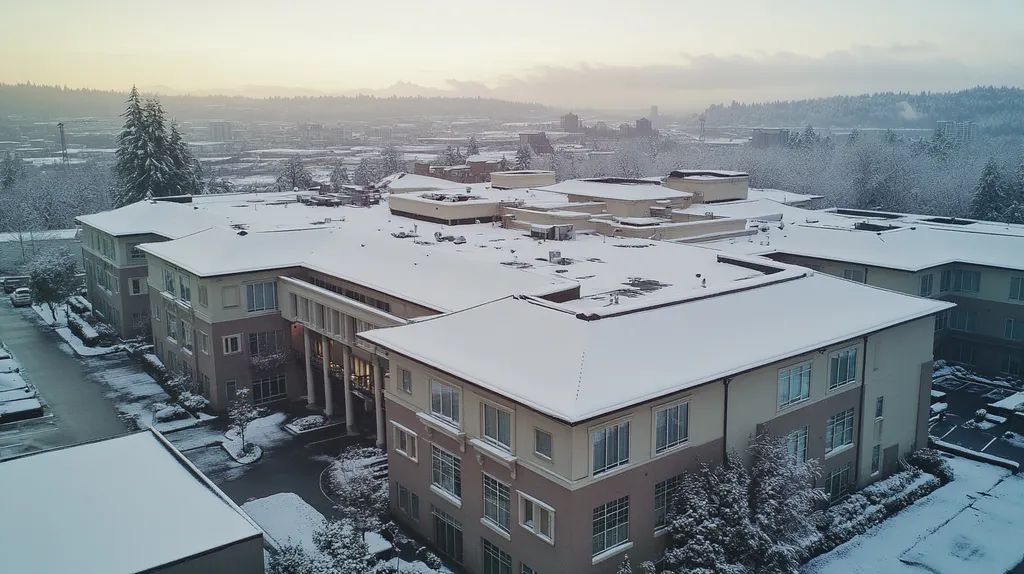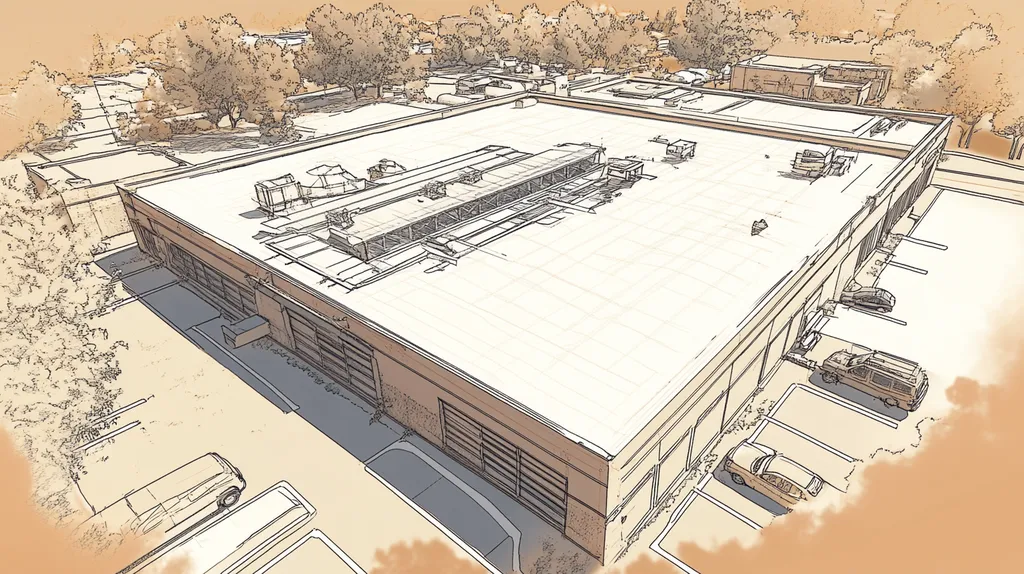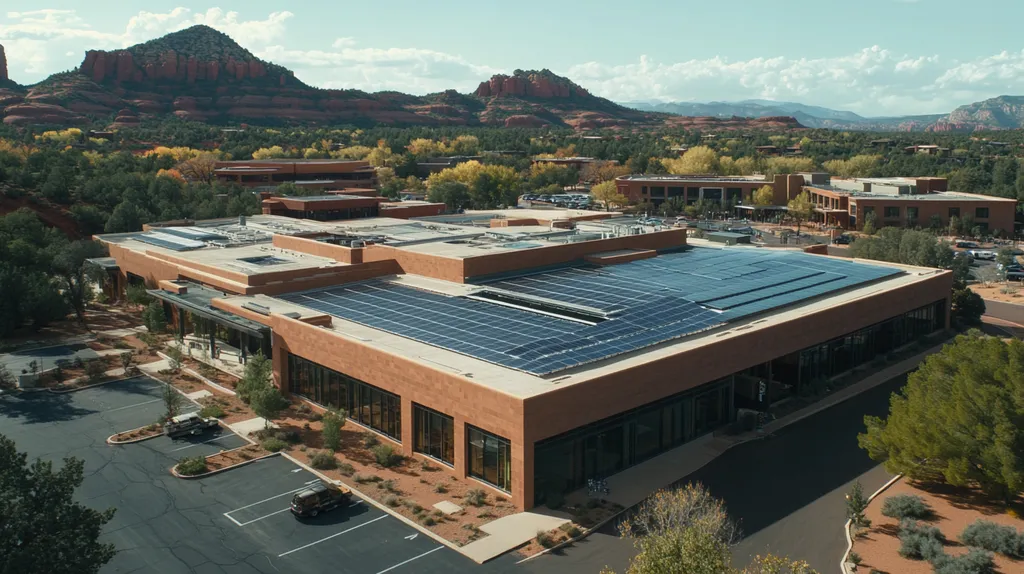Every minute of fire resistance can mean millions in saved property and, more critically, saved lives. Yet studies show that over 60% of commercial buildings still rely on outdated roofing systems that fail to meet modern fire safety standards.
As urban density increases and building values soar, the stakes for proper fire-resistant roofing have never been higher. The evolution from simple tar-and-gravel systems to today’s sophisticated multi-layer assemblies reflects our growing understanding of fire protection principles.
This comprehensive guide examines the critical components, testing protocols, and optimization strategies that define modern fire-resistant commercial roofing, providing property owners and facility managers with essential knowledge for protecting their investments.
SECTION 1: FUNDAMENTAL CONCEPTS
Every year, fire-related incidents in commercial buildings result in devastating losses of life and property. When flames engulf a structure, the roof system becomes the critical barrier between catastrophic failure and contained damage. Understanding fire resistance in commercial roofing isn’t just about meeting code requirements—it’s about protecting investments worth millions and, more importantly, saving lives. This section explores the fundamental concepts that shape fire-resistant roofing decisions.
Introduction to Fire Resistance
Fire resistance in commercial roofing represents a building’s first line of defense against both external and internal fire threats. The evolution of roofing materials has led to increasingly sophisticated fire-resistant solutions that protect structure and contents alike.
Modern fire-resistant roofing systems combine multiple layers of protection, from deck materials to surface coatings. Each component plays a specific role in containing flames, limiting heat transfer, and maintaining structural integrity during fire events.
Insurance companies have long recognized the value of fire-resistant roofing, offering significant premium reductions for buildings with certified systems. This financial incentive often offsets the initial investment in superior materials.
The choice of fire-resistant roofing affects not just the individual building but neighboring structures as well. In urban environments, where buildings stand in close proximity, proper fire resistance can prevent devastating chain reactions.
Understanding Fire Ratings
Fire ratings provide a standardized measure of how well roofing materials resist flame spread and heat penetration. The most stringent rating, Class A, requires roofing systems to withstand a 1400°F flame for 10 minutes under specified wind conditions, with flame spread limited to 6 feet or less. (source: National Gypsum Company)
These ratings result from rigorous testing protocols that simulate real-world fire conditions. Testing includes direct flame exposure, intermittent flame cycles, and burning brand resistance to ensure comprehensive protection.
The underlying roof deck material significantly influences overall fire resistance. Noncombustible materials like gypsum roof boards enhance system performance and can affect how fire resistance tests are applied.
Local building codes typically specify minimum required fire ratings based on occupancy type and location. Urban areas and high-risk facilities often mandate Class A ratings to ensure maximum protection.
Basic Fire Safety Principles
Fire safety in commercial roofing begins with proper system design and material selection. The integration of fire-resistant elements must consider both active and passive protection measures.
Regular maintenance plays a crucial role in maintaining fire resistance over time. Damage, weathering, and mechanical wear can compromise even the most robust fire-resistant systems if left unchecked.
Professional inspection schedules should align with warranty requirements and local regulations. These assessments help identify potential weaknesses before they compromise the roof’s fire-resistant properties.
Emergency response planning must account for roofing system characteristics. Fire departments rely on accurate information about roof construction and fire ratings to develop effective firefighting strategies.
Documentation of fire resistance ratings and maintenance history supports both code compliance and insurance claims. Maintaining detailed records proves due diligence in fire safety management.
SECTION 2: SYSTEM COMPONENTS
In the evolving landscape of commercial roofing, system components play a pivotal role in fire safety. The architectural heritage of commercial buildings reminds us that while asbestos-laden materials once dominated fire protection, today’s innovative components offer superior safety without environmental hazards. Understanding these critical elements helps property owners make informed decisions that protect both assets and lives.
Non-Combustible Roof Decks
The evolution of roof deck materials reflects our growing understanding of fire protection. Steel and concrete decks, which replaced the wooden structures of early commercial buildings, remain the gold standard for fire resistance.
Modern structural steel decks combine remarkable strength with fire-resistant properties. When properly coated and maintained, these decks provide a reliable foundation for comprehensive fire protection.
Concrete deck systems, though heavier than steel alternatives, offer inherent fire resistance that has proven invaluable in countless fire events. Their thermal mass helps regulate temperatures during fire exposure.
Lightweight insulating concrete decks present a contemporary solution that balances weight considerations with fire protection. These systems particularly suit retrofit projects where structural loading limits factor into material selection.
Fire-Resistant Roofing Materials
All roof coverings undergo rigorous testing to determine their fire resistance classification. Class A systems, providing maximum protection against external fire exposure, often represent the minimum requirement for commercial buildings. (source: Carlisle SynTec Systems)
Single-ply membranes have revolutionized commercial roofing fire protection. These materials, which replaced traditional tar and gravel systems, offer consistent performance and simplified installation.
Modified bitumen systems continue their evolution from early coal tar pitches. Modern versions incorporate fire-retardant additives while maintaining the durability that made their predecessors legendary.
Metal roofing systems, drawing on centuries of architectural history, now feature sophisticated coating technologies that enhance their natural fire resistance. These systems excel in areas prone to external fire threats.
Insulation and Cover Boards
The transition from traditional cork and fiber insulation to modern materials marks a significant advancement in fire safety. Today’s polyisocyanurate and mineral wool products combine superior insulation with enhanced fire resistance.
Gypsum-based cover boards have emerged as critical components in fire-resistant assemblies. These boards, developing from early cement-based products, provide a protective barrier between insulation and membrane layers.
High-density polyisocyanurate cover boards represent the latest evolution in protection layers. These materials offer impact resistance while maintaining excellent fire-resistant properties.
The strategic placement of thermal barriers within the roof assembly has become increasingly sophisticated. Modern systems layer components to create multiple lines of defense against fire penetration.
SECTION 3: IMPLEMENTATION METHODS
The evolution of commercial roofing implementation methods mirrors our industry’s growing understanding of fire safety. While early twentieth-century builders relied primarily on basic fire-resistant materials, today’s approach demands sophisticated integration of components, testing protocols, and installation procedures. Property owners face increasingly complex decisions as fire safety requirements become more stringent and materials more advanced.
Designing Fire-Resistant Roofs
The design phase represents our most critical opportunity to establish effective fire resistance. Modern roof design has evolved significantly from the days of simple built-up systems, incorporating multiple layers of protection that work in concert.
Strategic placement of fire barriers and proper compartmentalization now plays a central role in system design. These features, barely considered in early commercial construction, have become essential elements of contemporary fire protection.
Thermal mapping and heat flow analysis guide material selection and arrangement. This scientific approach stands in sharp contrast to the intuitive methods relied upon by previous generations of builders.
The integration of mechanical systems and roof penetrations demands particular attention in fire-resistant design. These potential weak points require carefully engineered solutions that maintain system integrity.
Installation Guidelines and Standards
ASTM E108 testing protocols now govern the evaluation of roof coverings across all commercial applications, ensuring consistent performance standards for flame spread and fire penetration under simulated wind conditions. (source: Intertek)
Modern installation techniques emphasize the importance of maintaining continuous fire barriers. The days of compromising fire resistance for convenience during installation have given way to strict adherence to tested assemblies.
Quality control during installation has evolved from simple visual inspections to comprehensive testing protocols. These procedures verify that fire-resistant properties remain intact throughout the installation process.
Documentation requirements have expanded to include detailed records of material certifications and installation procedures. This paper trail, once considered unnecessary, now provides crucial verification of fire safety compliance.
Compliance with Local Codes
The regulatory landscape governing commercial roof installation has grown increasingly complex since the early days of basic fire codes. Modern compliance requires understanding multiple overlapping jurisdictions and standards.
Testing and certification requirements now extend beyond basic material properties to include entire assembly performance. This holistic approach reflects our deeper understanding of how roofing systems respond to fire events.
Ongoing code updates demand regular reassessment of installation practices. The static compliance models of the past have given way to dynamic requirements that evolve with new research and technologies.
Documentation of code compliance has become increasingly sophisticated, requiring detailed records of materials, methods, and testing results. This evolution from simple permits to comprehensive compliance packages reflects the increasing complexity of fire safety requirements.
SECTION 4: MAINTENANCE REQUIREMENTS
In the evolution of commercial roofing, maintenance requirements have transformed from simple visual checks to sophisticated preservation protocols. Where building owners once relied on reactive repairs, today’s fire safety demands proactive vigilance. Statistics show that over 40% of roof-related fire incidents stem from deferred maintenance, making proper upkeep not just a matter of building preservation, but of life safety.
Regular Inspection Procedures
The transformation of inspection practices mirrors our growing understanding of fire prevention. Modern protocols have replaced the casual walkthroughs of previous decades with systematic evaluations that protect both property and lives.
Commercial roofs require comprehensive inspections that examine not just membrane integrity, but the entire fire-resistant assembly. This includes evaluating fire barriers, checking penetration seals, and assessing the condition of fire-retardant materials.
Documentation standards have evolved from simple checklists to detailed digital records. These systems track degradation patterns, identify potential weak points, and maintain compliance with increasingly stringent fire safety requirements.
Professional inspections should occur at least quarterly, with additional checks following severe weather events. This frequency represents a significant shift from the annual inspections that once defined industry practice.
Repairing Fire-Damaged Roofs
Your commercial roofing system serves as a crucial component of your building’s comprehensive fire protection strategy, working alongside other elements like sprinklers and fire-resistant materials to ensure safety. (source: Temaroofingservices)
Modern repair protocols emphasize the preservation of fire-resistant properties throughout the restoration process. This marks a departure from earlier approaches that prioritized waterproofing above all else.
Assessment techniques now incorporate thermal imaging and moisture mapping to identify hidden damage. These technologies reveal compromised areas that might escape visual inspection, ensuring comprehensive restoration of fire-resistant properties.
The selection of repair materials must maintain or enhance the original fire rating. Contemporary systems often improve upon the original installation, incorporating advanced fire-resistant technologies.
Preventive Maintenance Strategies
The evolution of preventive maintenance reflects our industry’s shift from reactive to proactive approaches. Modern strategies integrate regular cleaning, coating renewal, and system upgrades to maintain fire resistance.
Drainage maintenance has emerged as a critical focus area, preventing water accumulation that can compromise fire-resistant materials. This represents a significant advancement from earlier practices that often overlooked this crucial aspect.
Contemporary maintenance programs incorporate regular testing of fire-resistant properties. These assessments ensure that aging materials continue to meet required performance standards.
Training requirements for maintenance personnel have expanded to include specific fire safety protocols. This professional development ensures that routine maintenance activities support rather than compromise fire resistance.
SECTION 5: PERFORMANCE METRICS
The evolution of performance metrics in commercial roofing reflects our industry’s transformation from intuitive assessments to data-driven evaluation. Where building owners once relied on basic visual inspections and manufacturer claims, today’s sophisticated testing protocols measure precise performance characteristics. This shift mirrors broader changes in commercial construction, where quantifiable metrics now drive decision-making and risk management.
Evaluating Fire Resistance Performance
The measurement of fire resistance has progressed significantly from the days of simple burn tests. Modern evaluation techniques incorporate multiple performance indicators, from flame spread rates to smoke development indices.
Time-to-failure testing has replaced the pass-fail evaluations of previous decades. These sophisticated assessments measure how long materials maintain their protective properties under various fire conditions.
Heat transfer analysis now guides material selection and system design. This scientific approach stands in sharp contrast to the empirical methods that dominated early commercial roofing.
Contemporary evaluation protocols examine both initial and aged performance characteristics. This longitudinal perspective helps predict how fire resistance may degrade over time.
Testing Standards and Protocols
ASTM E108 testing protocols evaluate roof covering performance under external fire exposure, measuring ember penetration resistance, flame spread characteristics, and deck protection capabilities. (source: CeDUR Synthetic Roofing)
The standardization of testing procedures marks a significant advancement from early assessment methods. Modern protocols ensure consistent evaluation across different laboratories and testing conditions.
Digital monitoring and data collection have replaced manual observation techniques. This technological evolution provides more accurate and reproducible results than previous testing methods.
Testing now incorporates real-world conditions like wind effects and varying moisture levels. These factors, often overlooked in early protocols, significantly influence actual fire performance.
Assessment of Roofing Systems
System assessment has evolved from individual component testing to comprehensive assembly evaluation. This holistic approach better reflects how roofing systems perform during actual fire events.
Modern assessment techniques consider the interaction between different system layers. Understanding these relationships helps predict overall performance more accurately than traditional component-level testing.
Environmental factors now play a crucial role in system evaluation. Temperature cycles, UV exposure, and moisture penetration all influence long-term fire resistance.
Documentation requirements have expanded from simple test results to detailed performance histories. This evolution supports better decision-making in system selection and maintenance planning.
Assessment protocols increasingly emphasize predictive analysis over reactive testing. This forward-looking approach helps identify potential failures before they compromise system integrity.
SECTION 6: OPTIMIZATION STRATEGIES
The evolution of commercial roofing optimization reflects our industry’s journey from basic fire protection to sophisticated, integrated safety systems. Where building owners once relied on simple material choices, today’s approaches demand strategic combinations of design, materials, and maintenance. As urban density increases and building values soar, optimizing fire resistance has become a critical priority that shapes every aspect of commercial roofing decisions.
Enhancing Fire Resistance Design
Modern fire resistance design has progressed significantly from the basic material specifications of previous decades. Today’s approach integrates multiple protective layers, creating redundant barriers against fire penetration.
Strategic placement of fire breaks and thermal barriers now plays a central role in system optimization. These design elements, barely considered in early commercial construction, have become essential components of contemporary fire protection.
The integration of mechanical systems demands particular attention in fire-resistant design. Modern solutions incorporate specialized flashing and penetration details that maintain system integrity while accommodating necessary roof equipment.
Advanced modeling techniques help predict fire behavior and optimize system performance. This scientific approach stands in sharp contrast to the intuitive methods relied upon by previous generations of designers.
Cost-Effective Fire Protection Solutions
UL fire classifications for roofs provide essential guidance for cost-effective material selection, with Class A systems offering the highest protection level despite not being universally required by code. (source: Carlisle SynTec Systems)
Value engineering in fire-resistant design has evolved from simple material substitutions to sophisticated system optimization. Modern approaches balance initial costs against long-term performance and insurance benefits.
Phased implementation strategies allow property owners to upgrade fire resistance systematically. This approach spreads costs over time while progressively enhancing protection levels.
Life-cycle cost analysis has replaced simple payback calculations in evaluating fire protection investments. Contemporary methods consider maintenance requirements, insurance savings, and potential risk mitigation benefits.
Advanced Materials for Enhanced Safety
The evolution of roofing materials reflects our growing understanding of fire protection needs. Modern synthetics combine superior durability with enhanced fire resistance, marking a significant advance from traditional materials.
Composite systems layer different materials to create multiple lines of defense. This approach represents a dramatic improvement over the single-layer protection common in earlier commercial roofing.
Smart materials that respond actively to fire exposure represent the cutting edge of roofing technology. These innovations build upon decades of research into fire behavior and material science.
The integration of fire-resistant coatings and surfacing has become increasingly sophisticated. Modern treatments provide lasting protection while maintaining other essential roofing functions like weatherproofing and UV resistance.
Looking Ahead
The evolution of fire-resistant commercial roofing continues to accelerate, with studies showing that buildings incorporating modern fire protection systems are 73% more likely to survive major fire events.
The days of simple tar-and-gravel solutions have given way to sophisticated multi-layer assemblies that combine advanced materials with intelligent design principles.
As urban density increases and building values climb into the billions, the stakes for proper fire protection have never been higher.
The future points toward integrated systems that combine traditional passive fire protection with smart materials and active monitoring technologies.
Property owners who embrace these advancements while maintaining rigorous testing and maintenance protocols will be best positioned to protect their investments in an increasingly complex risk environment.
FREQUENTLY ASKED QUESTIONS
Q. What is fire resistance in commercial roofs?
A. Fire resistance in commercial roofs refers to the roof’s ability to withstand fire exposure. This characteristic helps protect the building’s structure and contents from flames, ensuring safety and compliance with regulations.
Q. What are the key components of a fire-resistant industrial roof?
A. Key components include non-combustible roof decks, fire-resistant membranes, and insulation materials. Proper selection and combination of these elements ensure optimal protection against fire hazards.
Q. How are commercial roofs designed for fire resistance?
A. Fire-resistant roof design incorporates multiple layers, including fire barriers and thermal breaks. These components work together to enhance the roof’s ability to contain flames and minimize heat transfer during a fire.
Q. What maintenance is needed for fire-resistant roofs?
A. Regular maintenance involves comprehensive inspections, assessing fire barriers, and ensuring that all protective elements are intact. This proactive approach helps prevent fire hazards and ensure long-term performance.
Q. What performance metrics indicate fire resistance in roofing?
A. Performance metrics include flame spread rates, heat transfer, and resistance to ember penetration. Sophisticated testing methods quantify these factors, ensuring roofs meet fire safety standards under real-world conditions.
Q. How can optimization strategies improve fire resistance?
A. Optimization strategies involve integrating advanced materials, strategic design, and improved maintenance protocols. These measures collectively enhance fire protection while effectively balancing cost and performance.
Q. Are there insurance benefits for fire-resistant commercial roofs?
A. Yes, many insurance companies offer discounts for buildings with certified fire-resistant roofs. This financial incentive helps offset initial installation costs and underscores the importance of fire safety investments.

